A Review of Carboniferous-Triassic Tectonic-Magmatic Evolution of Luang Prabang–Loei Metallogenic Belt in Laos and Thailand and Implications for Gold–Copper Mineralization
Abstract
1. Introduction
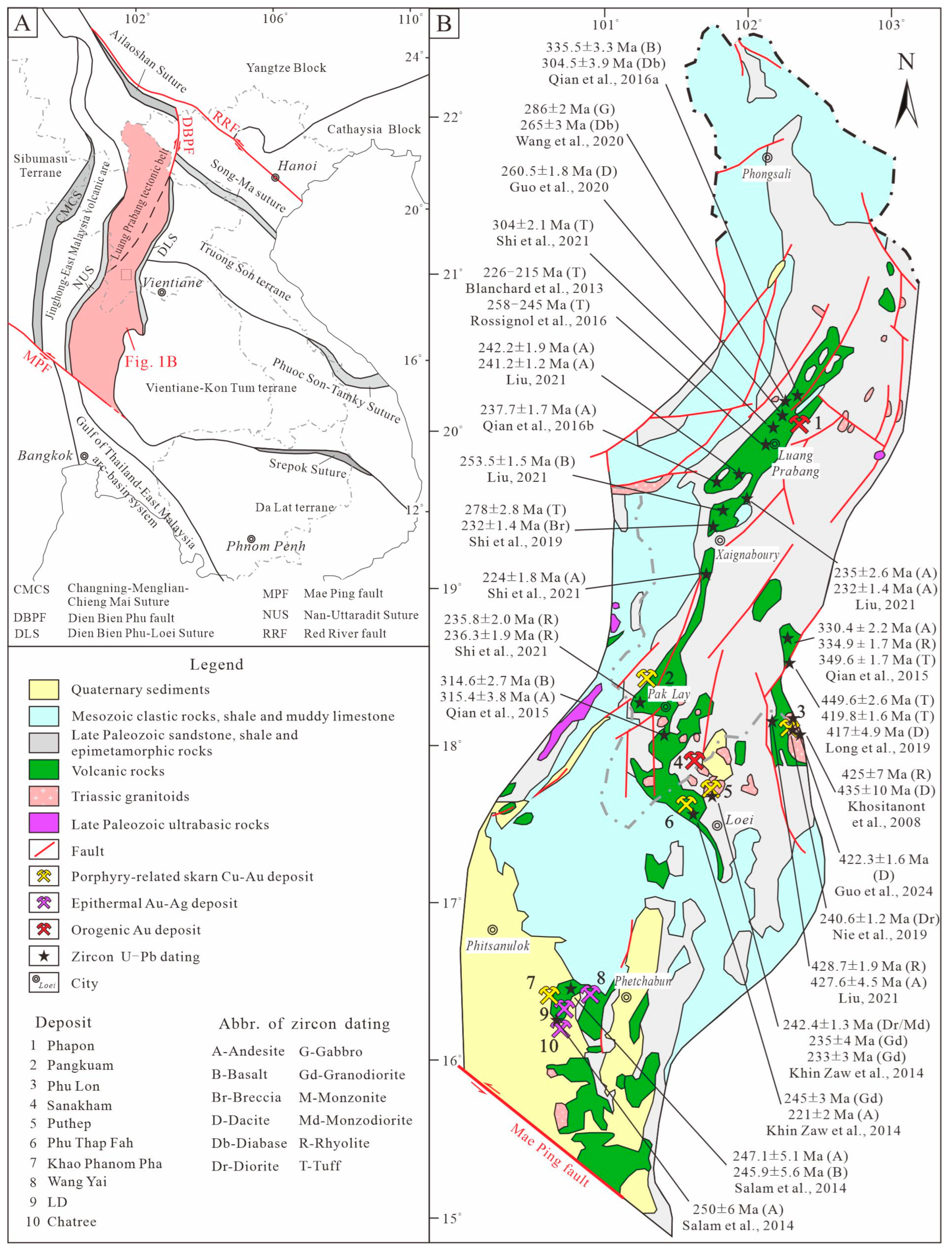
2. Regional Tectonic-Magmatic Evolution
2.1. Late Ordovician–Early Silurian
2.2. Carboniferous–Middle Permian
2.3. Late Permian–Middle Triassic
2.4. Late Triassic
3. Main Metallogenesis and Spatio-Temporal Distribution
3.1. Spatio-Temporal Distribution and Characteristics of Gold–Copper Deposits
3.2. Porphyry-Skarn Gold–Copper Deposit
3.2.1. Pangkuam Au-Cu Deposit
3.2.2. Phu Lon Cu-Au Deposit
3.2.3. Phu Thap Fah Au Deposit
3.3. Epithermal Au-Ag Deposits
| No. | Deposit | Deposit Type | Resource | Grade | Host Rocks | Intrusions/Ages | Metallogenic Age | Alteration Minerals | References |
|---|---|---|---|---|---|---|---|---|---|
| 1 | Phapon | Orogenic | Au, 20 t | Au, 6.28 g/t | Limestone | No known intrusion | 221.6 ± 7.6 Ma (calcite, U-Pb) | Calcite, siderite, magnitite, realgar | [24,25,26,29,63] |
| 2 | Pangkuam | Porphyry-skarn | Au, 20.5 t123456Cu, 37 kt | Cu, 0.69 wt% 123456Au, 2.41 g/t | Limestone, argillaceous siltstone | Intermediate-mafic intrusions | Contemporaneous with intrusions | Quartz, sericite, epidote, chlorite, K-feldspar, garnet | [3,23,53] |
| 3 | Phu Lon | Porphyry-skarn | Au, 3.5 t123456Cu, 130 kt | Cu, 2.4 wt%123456Au, 0.64 g/t | Limestone, volcaniclastics | Diorite and quartz monzonite porphyry/244~240 Ma | Contemporaneous with intrusions | Garnet, pyroxene, K-feldspar, tremolite, epidote, chlorite, calcite | [2,40,41] |
| 4 | Sanakham | Orogenic | Au, 10.6 t | Au, 3.05 g/t | Quartz monzodiorite and slate | Quartz monzodiorite | Late Triassic (inferred) | Quartz, sericite, carbonate | [27,28] |
| 5 | Puthep | Porphyry-skarn | Au, 15.6 t123456Cu, 1005 kt | Au, 0.078 g/t 123456Cu, 0.501 wt% | Sandstone, siltstone, and sandstone | Diorite and Monzodiorite porphyry/242.4 ± 1.3 Ma | Contemporaneous with intrusions | K-feldspar, sericite, garnet, epidote, chlorite, calcite | [2] |
| 6 | Phu Thap Fah | Skarn | Au, 14 t123456Cu, 9 kt123456Ag, 25 t | Au, 2.19 g/t123456Cu, 0.14 wt%123456Ag, 3.9 g/t | Siliciclastics and limestone | Granodiorite/245 ± 3 Ma | Contemporaneous with intrusions | Garnet, pyroxene, quartz, epidote, calcite, chlorite | [2] |
| 7 | Khao Phanom Pha | Skarn | No data | No data | Felsic andesitic123456volcaniclastics | No known intrusion | No data | quartz, tremolite,123456sericite | [2] |
| 8 | Wang Yai | Low-S epithermal | No data | No data | Volcaniclastics, 123456volcanic sandstone | Post-ore diorite/188.5 ± 0.3 Ma | Late Permian–early Triassic (inferred) | Quartz, pyrite, calcite, adularia, sericite, chlorite | [2] |
| 9 | LD Prospect | Low-S epithermal | Au, 3.2 t123456Ag, 290 t | 1.1 g/t Au12345610 g/t Ag | Andesite | No known intrusion | Late Permian-early Triassic (inferred) | Quartz, pyrite, calcite, adularia, sericite, chlorite | [2] |
| 10 | Chatree | Low-S epithermal | Au, 106.4 t123456Ag, 916.2 t | Au, 0.65 g/t123456Ag, 5.6 g/t | Andesite breccias, volcanogenic sedimentary rocks | Granodiorite/244 ± 1 Ma | 250.9 ± 0.8 Ma (Adularia, 40Ar/39Ar) | Quartz, calcite, adularia, sericite, chlorite, illite, smectite | [2,22,51] |
3.4. Orogenic Gold Deposits
3.4.1. Phapon Gold Deposit
3.4.2. Sanakham Gold Deposit
4. Paleo-Tethys Au-Cu Mineralization in the Luang Prabang–Loei Metallogenic Belt
4.1. Late Permian–Early Triassic Subduction Period
4.2. Early–Middle Triassic Closure Period
4.3. Late Triassic Continental Collision Period
5. Conclusions
Author Contributions
Funding
Data Availability Statement
Acknowledgments
Conflicts of Interest
References
- Goldfarb, R.J.; Taylor, R.D.; Collins, G.S.; Goryachev, N.A.; Orlandini, O.F. Phanerozoic continental growth and gold metallogeny of Asia. Gondwana Res. 2014, 25, 48–102. [Google Scholar] [CrossRef]
- Zaw, K.; Meffre, S.; Lai, C.K.; Burrett, C.; Santosh, M.; Graham, I.; Manaka, T.; Salam, A.; Kamvong, T.; Cromie, P. Tectonics and metallogeny of mainland Southeast Asia—A review and contribution. Gondwana Res. 2014, 26, 5–30. [Google Scholar] [CrossRef]
- Zhao, Y.P.; Kang, T.S.; Ning, G.C.; Ge, H.; Pan, H. Geochemical characteristics of the volcanic intrusive complex in the Pangkuam copper-gold deposit of Laos and its geological significance. Acta Petrol. Mineral. 2017, 36, 281–294, (In Chinese with English Abstract). [Google Scholar]
- Liu, S.S. Study on the Tectonics-Magmatic-Mineralization of the Luang Prabang-Loei Copper-Gold Metallogenic Belt. Ph.D. Thesis, Chengdu University of Technology, Chengdu, China, 2021. (In Chinese with English Abstract). [Google Scholar]
- Guo, L.N.; Liu, S.S.; Nie, F.; Wu, S.Y.; Xu, S.W.; Shi, M.F. Paleo-Tethys tectonic-magmatic evolution and gold-copper metallogenesis in Luang Prabang (Laos)—Loei (Thailand) metallogenic belt. Sediment. Geol. Tethyan Geol. 2022, 42, 228–241, (In Chinese with English Abstract). [Google Scholar]
- Feng, Q.L.; Chonglakmani, C.; Helmcke, D.; Ingavat-Helmcke, R.; Liu, B.P. Correlation of Triassic stratigraphy between the Simao and Lampang-Phrase Basins: Implications for the tectonopaleogeography of Southeast Asia. J. Asian Earth Sci. 2005, 24, 777–785. [Google Scholar] [CrossRef]
- Chen, Y.Q.; Liu, J.L.; Feng, Q.L. Geology and Ore Deposits Associated with Granites in Indo-China Peninsula of Southeastern Asia; Geological Publishing House: Beijing, China, 2010; pp. 1–213. (In Chinese) [Google Scholar]
- Deng, J.; Wang, Q.F.; Li, G.J.; Li, C.S.; Wang, C.M. Tethys tectonic evolution and its bearing on the distribution of important mineral deposits in the Sanjiang region, SW China. Gondwana Res. 2014, 26, 419–437. [Google Scholar] [CrossRef]
- Deng, J.; Wang, Q.F.; Li, G.J.; Santosh, M. Cenozoic tectono-magmatic and metallogenic processes in the Sanjiang region, southwestern China. Earth-Sci. Rev. 2014, 128, 268–299. [Google Scholar] [CrossRef]
- Deng, J.; Wang, Q.F.; Gao, L.; He, W.Y.; Yang, Z.Y.; Zhang, S.H.; Chang, L.J.; Li, G.J.; Sun, X.; Zhou, D.Q. Differential crustal rotation and its control on giant ore clusters along the eastern margin of Tibet. Geology 2021, 49, 47855. [Google Scholar] [CrossRef]
- Deng, J.; Wang, Q.F.; Sun, X.; Yang, L.; Groves, D.I.; Shu, Q.H.; Gao, L.; Yang, L.Q.; Qiu, K.F.; Wang, C.M.; et al. Tibetan ore deposits: A conjunction of accretionary orogeny and continental collision. Earth-Sci. Rev. 2022, 235, 104245. [Google Scholar] [CrossRef]
- Luo, L.; Wang, D.B.; You, T.H.; Xie, T.; Jiang, L.L.; Huang, X.M. New progress in the study of the Devon-Carboniferous Nanduan Formation in the eastern Changning-Menglian Belt and its implications for the evolution of the Tethys Ocean. Sediment. Geol. Tethyan Geol. 2022, 42, 242–259. [Google Scholar] [CrossRef]
- Pan, G.T.; Wang, L.Q.; Yin, F.G.; Geng, Q.R.; Li, G.M.; Zhu, D.C. Researches on geological-tectonic evolution of Tibetan Plateau: A review, recent advances, and directions in the future. Sediment. Geol. Tethyan Geol. 2022, 42, 151–175. [Google Scholar] [CrossRef]
- Qian, X.; Feng, Q.L.; Yang, W.Q.; Wang, Y.J.; Chonglakmani, C.; Monjai, D. Arc-like volcanic rocks in NW Laos: Geochronological and geochemical constraints and their tectonic implications. J. Asian Earth Sci. 2015, 98, 342–357. [Google Scholar] [CrossRef]
- Qian, X.; Feng, Q.L.; Wang, Y.J.; Chonglakmani, C.; Monjai, D. Geochronological and geochemical constraints on the mafic rocks along the Luang Prabang zone: Carboniferous back-arc setting in northwest Laos. Lithos 2016, 245, 60–75. [Google Scholar] [CrossRef]
- Qian, X.; Feng, Q.L.; Wang, Y.J.; Yang, W.Q.; Chonglakmani, C.; Monjai, D. Petrochemistry and tectonic setting of the Middle Triassic arc-like volcanic rocks in the Sayabouli area, NW Laos. J. Asian Earth Sci. 2016, 27, 365–377. [Google Scholar] [CrossRef]
- Wang, Y.J.; He, H.Y.; Cawood, P.A.; Sritha, B.; Feng, Q.L.; Fan, W.M.; Zhang, Y.Z.; Qian, Q. Geochronological, elemental, and Sr-Nd-Hf-O isotopic constraints on the petrogenesis of the Triassic post-collisional granitic rocks in NW Thailand and its Paleotethyan implications. Lithos 2016, 266–267, 264–286. [Google Scholar] [CrossRef]
- Wang, Y.J.; Qian, X.; Cawood, P.A.; Liu, H.C.; Feng, Q.L.; Zhao, G.C.; Zhang, Y.H.; He, H.Y.; Zhang, P.Z. Closure of the East Paleotethyan Ocean and amalgamation of the Eastern Cimmerian and Southeast Asia continental fragments. Earth Sci. Rev. 2018, 186, 195–230. [Google Scholar] [CrossRef]
- Guo, L.N.; Hou, L.; Nie, F.; Liu, S.S.; Xu, S.W.; Zhang, Q.M. Zircon U-Pb dating of quartz-diorite from Luang Prabang tectonic belt in Laos: Implication for eastward subduction of the Paleo-Tethys Ocean. Sediment. Geol. Tethyan Geol. 2020, 40, 68–75, (In Chinese with English Abstract). [Google Scholar]
- Shi, M.F.; Zaw, K.; Liu, S.S.; Xu, B.C.; Meffre, S.; Cong, F.; Nie, F.; Peng, Z.M.; Wu, Z.B. Geochronology and petrogenesis of Carboniferous and Triassic volcanic rocks in NW Laos: Implications for the tectonic evolution of the Loei Fold Belt. J. Asian Earth Sci. 2021, 208, 104661. [Google Scholar] [CrossRef]
- Kamvong, T.; Zaw, K.; Harris, A. Fluid chemistry of the Phu Lon Cu–Au skarn deposit, Loei Fold Belt, northeastern Thailand: Implication for ore genesis. Geochim. Cosmochim. Acta 2006, 70 (Suppl. S18), 304. [Google Scholar]
- Salam, A.; Zaw, K.; Meffre, S.; McPhie, J.; Lai, C.K. Geochemistry and geochronology of epithermal Au-hosted Chatree volcanic sequence: Implication for the tectonic setting of the Loei Fold Belt in central Thailand. Gondwana Res. 2014, 26, 198–217. [Google Scholar] [CrossRef]
- Zhao, Y.P.; Mo, J.P.; Wang, X.M. Clues for prospecting and metallogenic prognosis of Pangkuam Cu-Au deposit in Laos. Miner. Resour. Geol. 2015, 29, 178–182, (In Chinese with English Abstract). [Google Scholar]
- Guo, L.N.; Liu, S.S.; Hou, L.; Wang, J.T.; Shi, M.F.; Zhang, Q.M.; Nie, F.; Yang, Y.F.; Peng, Z.M. Fluid inclusion and C-H-O isotope geochemistry of the Phapon gold deposit, NW Laos: Implications for fluid source and ore genesis. J. Earth Sci. 2019, 30, 80–94. [Google Scholar] [CrossRef]
- Guo, L.N.; Hou, L.; Liu, S.S.; Zhang, Q.M.; Xu, S.W.; Shi, M.F.; Zeng, X.T. Ore-fluid sources and genesis of Phapon gold deposit, Laos: Constraint from REE and C, O, S isotopic characteristics. Miner. Depos. 2019, 38, 4–21, (In Chinese with English Abstract). [Google Scholar]
- Guo, L.N.; Hou, L.; Liu, S.S.; Nie, F. REE geochemistry and C-O isotope characteristics of hydrothermal calcites: Implications for fluid–rock reaction and ore-forming processes in the Phapon gold deposit, NW Laos. Minerals 2018, 8, 438–459. [Google Scholar] [CrossRef]
- Guo, L.N.; Deng, J.; Hou, L.; Liu, S.S.; Yang, Y.F.; Nie, F.; Xu, S.W.; Zeng, X.T. Gold source and deposition in the Sanakham gold deposit, SW Laos: Constrains from textures, trace element geochemistry and in-situ sulfur isotopes of pyrite. Ore Geol. Rev. 2024, 167, 106003. [Google Scholar] [CrossRef]
- Liu, S.S.; Guo, L.N.; Ding, J.; Hou, L.; Xu, S.W.; Shi, M.F.; Liang, H.M.; Nie, F.; Cui, X.Y. Evolution of Ore-Forming Fluids and Gold Deposition of the Sanakham Lode Gold Deposit, SW Laos: Constrains from Fluid Inclusions Study. Minerals 2022, 12, 259. [Google Scholar] [CrossRef]
- Guo, L.N.; Tang, Y.W.; Hou, L.; Liu, S.S.; Huang, C.M.; Han, Z.W.; Xu, S.W.; Luo, Z.B.; Liang, H.M. Late Triassic orogenic gold mineralization along the northwest margin of the Indochina Block: Revealed from calcite U-Pb ages and geochemistry of the Phapon gold deposit, Laos. J. Asian Earth Sci. 2024, 276, 106350. [Google Scholar] [CrossRef]
- Nualkhao, P.; Takahashi, R.; Imai, A.; Charusiri, P. Petrochemistry of granitoids along the Loei Fold Belt, Northeastern Thailand. Resour. Geol. 2018, 68, 395–424. [Google Scholar] [CrossRef]
- Wang, T.R.; Hou, L.; Lin, F.C.; Xiong, F.H.; Guo, Y.; Guo, L.N.; Xu, S.W.; Zeng, X.T.; Shi, M.F.; Cong, F. Paleo-Tethys tectonic-magmatic evolution and mineralization in the Truong Son metallogenic belt, Laos-Vietnam. Sediment. Geol. Tethyan Geol. 2022, 42, 212–227. [Google Scholar] [CrossRef]
- Hall, R. Australia–SE Asia collision: Plate tectonics and crustal flow. Geol. Soc. Lond. Spec. Publ. 2011, 355, 75–109. [Google Scholar] [CrossRef]
- Liu, S.S.; Yang, Y.F.; Guo, L.N.; Nie, F.; Peng, Z.M.; Pan, G.T. Tectonic characteristics and metallogeny in Southeast Asia. Geol. China 2018, 45, 863–889, (In Chinese with English Abstract). [Google Scholar]
- Veeravinantanakul, A.; Takahashi, R.; Agangi, A.; Ohba, T.; Watanabe, Y.; Elburg, M.A.; Ueckermann, H.; Kanjanapayont, P.; Charusiri, P. Zircon Hf-isotope constraints on the formation of metallic mineral deposits in Thailand. Resour. Geol. 2021, 71, 436–469. [Google Scholar] [CrossRef]
- Long, Y.Z.; Zhang, D.X.; Huang, D.Z.; Yang, X.Y.; Chen, S.S.; Bayless, R.C. Age, composition and tectonic implications of late Ordovicianearly Silurian igneous rocks of the Loel Volcanic Belt, NW Laos. Int. Geol. Rev. 2019, 61, 1940–1956. [Google Scholar] [CrossRef]
- Khositanont, S.; Panjasawatwong, Y.; Ounchanum, P.; Thanasuthipitak, T.; Zaw, K.; Meffre, S. Petrochemistry and zircon age determination of Loei–Phetchabun volcanic rocks. In Proceedings of the International Symposia on Geoscience Resources and Environments of Asian Terranes (GREAT 2008), 4th IGCP 516 and 5th APSEG, Bangkok, Thailand, 24–26 November 2008; Chutakositkanon, V., Sutthirat, C., Charoentitirat, T., Eds.; pp. 272–278. [Google Scholar]
- Guo, L.N.; Liao, Z.W.; Huang, C.M.; Yang, Y.F.; Zhang, B.; Xu, S.W.; Liang, H.M.; Zeng, X.T. LA-ICP-MS zircon U-Pb dating of dacite in the Sangthong Au mining area, Luang Prabang-Loei metallogenetic belt, SW Laos. China Geol. 2024, 7, 1–3. [Google Scholar] [CrossRef]
- Wang, Y.J.; Yang, T.X.; Zhang, Y.Z.; Qian, X.; Gan, C.S.; Wang, Y.K.; Wang, Y.; Vongpaseuth, S. Late Paleozoic back-arc basin in the Indochina block: Constraints from the mafic rocks in the Nan and Luang Prabang tectonic zones, Southeast Asia. J. Asian Earth Sci. 2020, 195, 104333. [Google Scholar] [CrossRef]
- Plank, T.; Languir, C.H. The chemical compositions of subducting sediment and its consequences for the crust and mantle. Chem. Geol. 1998, 145, 325–394. [Google Scholar] [CrossRef]
- Sone, M.; Metcalfe, I. Parallel Tethyan sutures in mainland Southeast Asia: New insights for Paleo-Tethys closure and implications for the Indosinian orogeny. Geoscience 2008, 340, 166–179. [Google Scholar] [CrossRef]
- Rossignol, C.; Bourquin, S.; Poujol, M.; Hallot, E.; Dabard, M.P.; Nalpas, T. The volcaniclastic series from the Luang Prabang Basin, Laos: A witness of a Triassic magmatic arc? J. Asian Earth Sci. 2016, 120, 159–183. [Google Scholar] [CrossRef]
- Nie, F.; Liu, S.S.; Yang, Y.F.; Peng, Z.M.; Guo, L.N. Zircon U-Pb dating of the diorite of Phu Lon skarn Cu-Au deposit in Thailand and its significance. Sediment. Geol. Tethyan Geol. 2019, 39, 71–78, (In Chinese with English Abstract). [Google Scholar]
- Kamvong, T.; Zaw, K. The origin and evolution of skarn-forming fluids from the Phu Lon deposit, northern Loei Fold Belt, Thailand. Evidence from fluid inclusion and sulfur isotope studies. J. Asian Earth Sci. 2009, 34, 624–633. [Google Scholar] [CrossRef]
- Blanchard, S.; Rossignol, C.; Bourquin, S.; Dabard, M.P.; Hallot, E.; Nalpas, T.; Poujol, M.; Battail, B.; Jalil, N.E.; Steyer, J.S.; et al. Late Triassic volcanic activity in South-East Asia: New stratigraphical, geochronological and paleontological evidence from the Luang Prabang Basin (Laos). J. Asian Earth Sci. 2013, 70–71, 8–26. [Google Scholar] [CrossRef]
- Shi, M.F.; Wu, Z.B.; Liu, S.S.; Peng, Z.M.; Guo, L.N.; Nie, F.; Xu, S.W. Geochronology and petrochemistry of volcanic rocks in the Xaignabouli Area, NW Laos. J. Earth Sci. 2019, 30, 37–51. [Google Scholar] [CrossRef]
- Zaw, K.; Rodmanee, T.; Khositanont, S.; Thanasuthipitak, T.; Ruamkid, S. Geology and genesis of Phu Thap Fah gold skarn deposit, northeastern Thailand: Implications for reduced gold skarn formation and mineral exploration. In Proceedings of the GEOTHAI’07 International Conference on Geology of Thailand, Bangkok, Thailand, 21–22 November 2007; Tantiwanit, W., Ed.; pp. 93–95. [Google Scholar]
- Zaw, K.; Meffre, S.; Burrett, C.; Shi, M.F.; Hu, F.; Lai, C.K. Recent advances in studies of tectonics and metallogeny of Loei and Truong Son Fold Belts in SE Asia. In Proceedings of the Keynote Address, GEOINDO 2022, Khon Kaen, Thailand, 11–12 February 2022. [Google Scholar]
- Zaw, K.; Meffre, S.; Salam, A. The geochronological and metallogenic framework of ore deposits along Loei Fold Belt, Laos PDR, and Thailand: Extension into Myanmar and Cambodia. International Symposium on Earth Resources and Geoenvironment Technology. In Proceedings of the Keynote, Phnom Penh, Cambodia, 18–19 February 2022. [Google Scholar]
- Cong, F.; Wu, F.Y.; Li, W.C.; Wang, J.G.; Hu, F.Y.; He, D.F.; Ji, W.Q.; Lin, W.; Sein, K. Petrogenesis of the Main Range and Eastern Province granites in eastern Myanmar: New insights from zircon U-Pb ages and Sr–Nd isotopes. Lithos 2021, 382–383, 105895. [Google Scholar] [CrossRef]
- Hu, F.; Wu, F.Y.; Wang, J.G.; Ducea, M.N.; Chapman, J.B.; Zaw, K.; Lin, W.; Sein, K.; Meffre, S. Newly discovered Early Carboniferous and Late Permian magmatic rocks in eastern Myanmar: Implications for the tectonic evolution of the eastern Paleo-Tethys. J. Asian Earth Sci. 2022, 227, 105093. [Google Scholar] [CrossRef]
- Seang, S.; Zaw, K.; Kret, K.; Belousov, I.; Yonezu, K.; Watanabe, K.; Kong, S.; Hoeun, S.; Charles, M.C. Geochemistry and geochronology of magmatic rocks in Southwestern and Northeastern Cambodia: Implications for the tec-tonic evolution and metallogenesis of the Loei Fold Belt. In Proceedings of the 20th AOGS Conference, Singapore, 30 July–4 August 2023. [Google Scholar]
- Tangwattananukul, L.; Ishiyama, D.; Matsubaya, O.; Mizuta, T.; Charusiri, P.; Sato, H.; Sera, K. Characteristics of Triassic epithermal Au mineralization at the Q prospect, Chatree mining area, Central Thailand. Resour. Geol. 2014, 64, 167–181. [Google Scholar] [CrossRef]
- Makoundi, C.; Zaw, K.; Large, R.R.; Meffre, S.; Lai, C.K.; Hoe, T.G. Geology, geochemistry, and metallogenesis of the Selinsing gold deposit, central Malaysia. Gondwana Res. 2014, 26, 241–261. [Google Scholar] [CrossRef]
- Shi, Q.; Zhao, Y.P.; Chi, Z.D.; Kang, T.S.; Hu, Y.D. Geological characteristics and prospecting direction of Pangkuam Cu-Au deposit in Laos. Miner. Resour. Geol. 2016, 30, 568–572, (In Chinese with English Abstract). [Google Scholar]
- Zhao, Y.P.; Chen, X.F.; Kang, T.S.; (China Nonferrous Guilin Institute of Mineral Geology Co., LTD, Guilin, China). Demonstration Study on Mineralization and Exploration Technology of Pangkuam Copper-Gold Deposit, Laos. Unpublished report, 2018.
- Rodmanee, T. Genetic Model of Phu Thap Fah Gold Deposit, Ban Huai Phuk Amphoe Wang Saphung, Changwat Loei. Unpublished Master’s Thesis, Chiang Mai University, Chiang Mai, Thailand, 2000. [Google Scholar]
- Zaw, K.; Rodmanee, T.; Khositanont, S.; Ruamkid, S. Geology, mineralogy and genesis of Phu Thap Fah gold skarn deposit, Northeast Thailand. Implications for reduced gold skarn formation. In Proceedings of the 33rd International Geological Congress (IGC), Oslo, Norway, 5–14 August 2008. CD-ROM. [Google Scholar]
- Zaw, K.; Kamvong, T.; Khositanont, S.; Mernagh, T.P. Oxidized vs. reduced Cu–Au skarn formation and implication for exploration, Loei and Truong Son fold belts, SE Asia. In Proceedings of the International Conference on Geology, Geotechnology and Mineral Resources of Indochina (GEOINDO 2011), Khon Kean, Thailand, 1–3 December 2011; pp. 97–100. [Google Scholar]
- Crow, M.J.; Zaw, K. Metalliferous minerals. In The Geology of Thailand; Ridd, M.F., Barber, A.J., Crow, M.J., Eds.; The Geological Society: London, UK, 2011; pp. 459–492. [Google Scholar]
- Oyman, T.; Zaw, K.; Ghaderi, M.; Lai, C.K. Editorial: Orogenic gold deposits. Front. Earth Sci. 2024, 11, 1345511. [Google Scholar] [CrossRef]
- Salam, A. A Geological, Geochemical, and Metallogenic Study of the Chatree Epithermal Deposit, Petchabun Province, Central Thailand. Doctoral Dissertation, ARC Centre of Excellence in Ore Deposits (CODES), University of Tasmania, Hobart, Australia, 2013. [Google Scholar]
- Charusiri, P.; Pongsapich, W.; Sutthirat, C. Petrochemistry of Probable Gem-Bearing Basalts in Sop Prab-Kokha, Changwat Lampang; Chulalongkorn University: Bangkok, Thailand, 1996. [Google Scholar]
- Yang, C.Z.; Shen, L.X.; Zhou, L.; Feng, J.Z.; Liu, X.W. Characteristics of geology and structural geochemistry and metallogenic mechanism of Phapon gold deposit in Laos. Miner. Resour. Geol. 2017, 31, 11–22, (In Chinese with English Abstract). [Google Scholar]
- Niu, Y.J.; Sun, H.Y.; Wang, J.S.; Chen, J.Y.; Liu, Z.Y.; Wang, K. Study on feature of ore-forming fluid and ore genesis of Phapon gold deposit, Luangprobang, Laos. Contrib. Geol. Miner. Resour. Res. 2017, 32, 317–323, (In Chinese with English Abstract). [Google Scholar]
- Niu, Y.J.; Liu, W.; Gao, Y.L.; Liu, Z.Y.; Yang, H.L.; Yu, W.X. Geochemical characteristics of stable isotopes and REE at the Phapon gold deposit in Laos. Geol. Surv. Res. 2015, 38, 277–283, (In Chinese with English Abstract). [Google Scholar]
- Lu, F.F.; Yang, H.L.; Tong, W.H.; Zhao, M.S. Inclusion characteristics of Phabon gold deposit, Laos. Henan Sci. 2015, 33, 1985–1989, (In Chinese with English Abstract). [Google Scholar]
- Xue, L.H.; Shi, L.H. Mineralization and metallogenic evolution of the Phapon gold deposit, Laos. Geol. Surv. Res. 2016, 39, 191–203, (In Chinese with English Abstract). [Google Scholar]
- Groves, D.I.; Goldfarb, R.J.; Gebre-Mariam, M.; Hagemann, S.G.; Robert, F. Orogenic gold deposits: A proposed classification in the context of their crustal distribution and relationship to other gold deposit types. Ore Geol. Rev. 1998, 13, 7–27. [Google Scholar] [CrossRef]
- Qiu, K.F.; Deng, J.; Li, S.S.; Jowitt, S.; Hetherington, C.J.; Balen, D. Roles and perspectives of A- and I-type magmas in rare earth element and gold mineralization. Geol. Soc. Am. Bull. 2023, 136, 1238–1250. [Google Scholar] [CrossRef]
- He, D.Y.; Qiu, K.F.; Simon, A.C.; Pokrovski, G.S.; Yu, H.C.; Connolly, J.A.D.; Li, S.S.; Turner, S.; Wang, Q.F.; Yang, M.F.; et al. Mantle oxidation by sulfur drives the formation of giant gold deposits in subduction zones. Proc. Natl. Acad. Sci. USA 2024, 121, e2404731121. [Google Scholar] [CrossRef] [PubMed]
- Qiu, K.F.; Romer, R.L.; Long, Z.Y.; Williams-Jones, A.E.; Yu, H.C.; Turner, S.; Wang, Q.F.; Li, S.S.; Zhang, J.Y.; Duan, H.R.; et al. The role of an oxidized lithospheric mantle in gold mobilization. Sci. Adv. 2024, 10, eado6262. [Google Scholar] [CrossRef] [PubMed]
- Qiu, K.F.; Deng, J.; Laflamme, C.; Long, Z.Y.; Wan, R.Q.; Moynier, F.; Yu, H.C.; Zhang, J.Y.; Ding, Z.J.; Goldfarb, R.J. Giant Mesozoic gold ores derived from subducted oceanic slab and overlying sediments. Geochim. Cosmochim. Acta 2023, 343, 133–141. [Google Scholar] [CrossRef]
- Zhang, J.Y.; Qiu, K.F.; Yin, R.S.; Long, Z.Y.; Feng, Y.C.; Yu, H.C.; Gao, Z.Y.; Deng, J. Lithospheric mantle as a metal storage reservoir for orogenic gold deposits in active continental margins: Evidence from Hg isotopes. Geology 2024, 52, 423–428. [Google Scholar] [CrossRef]
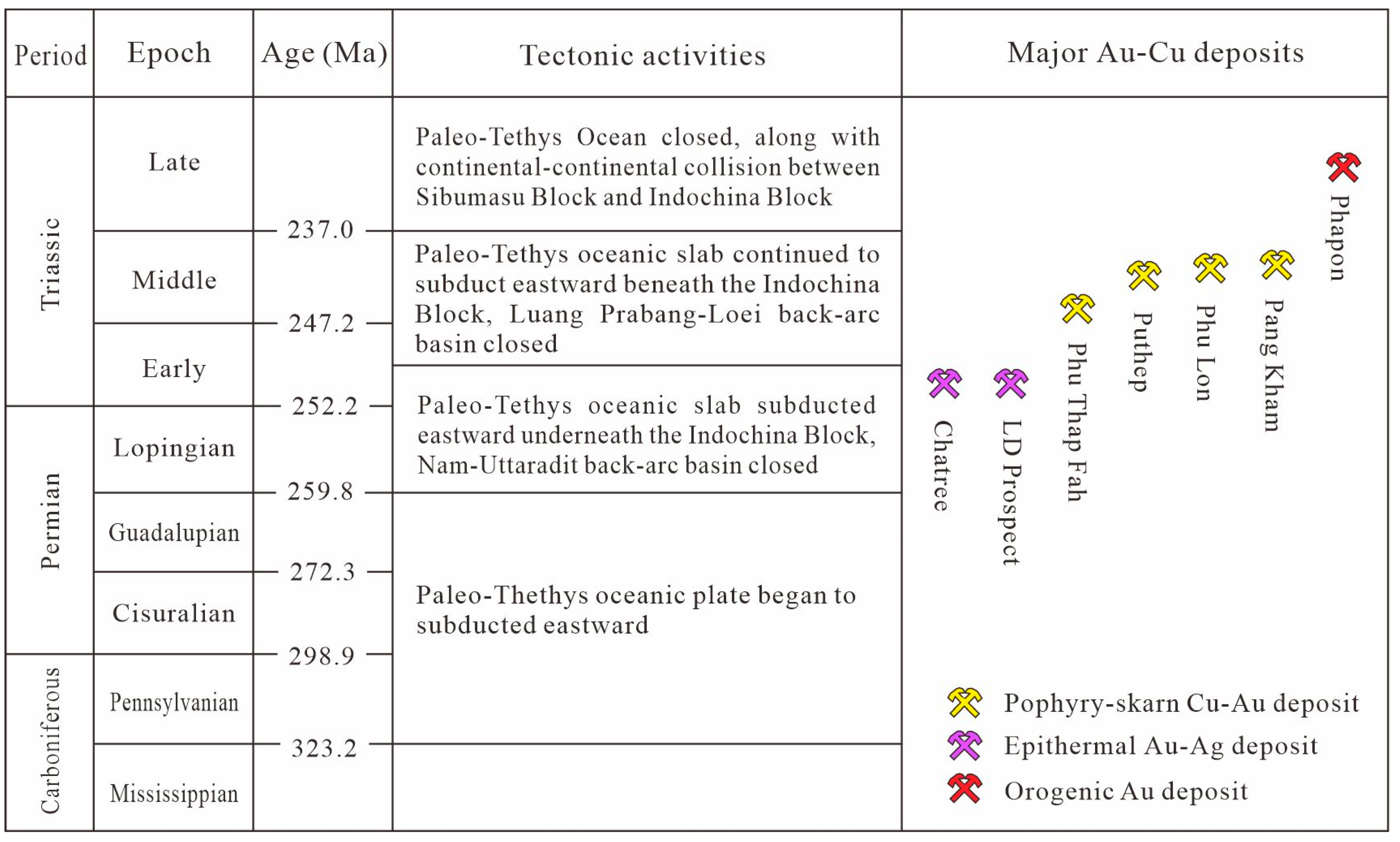
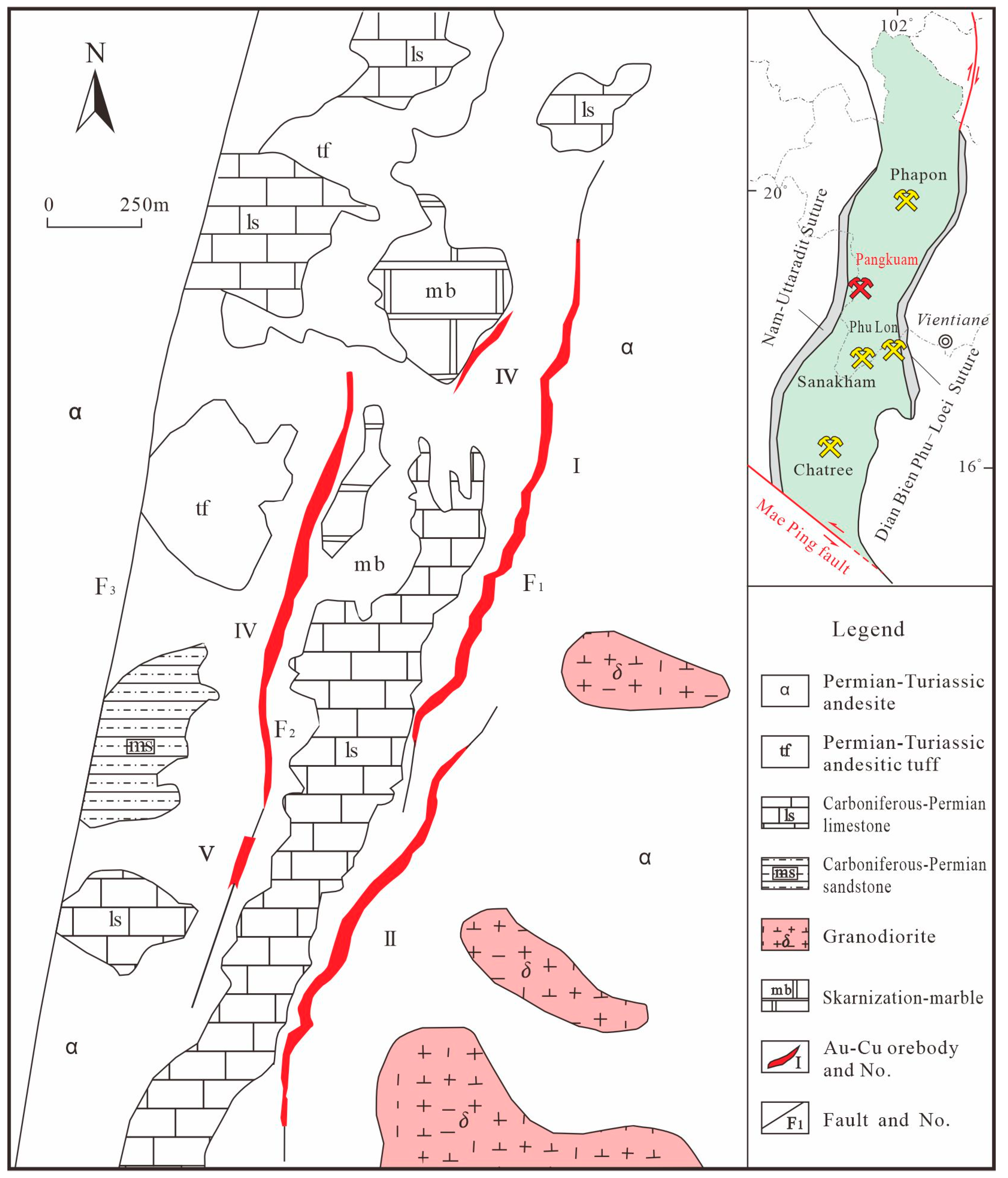

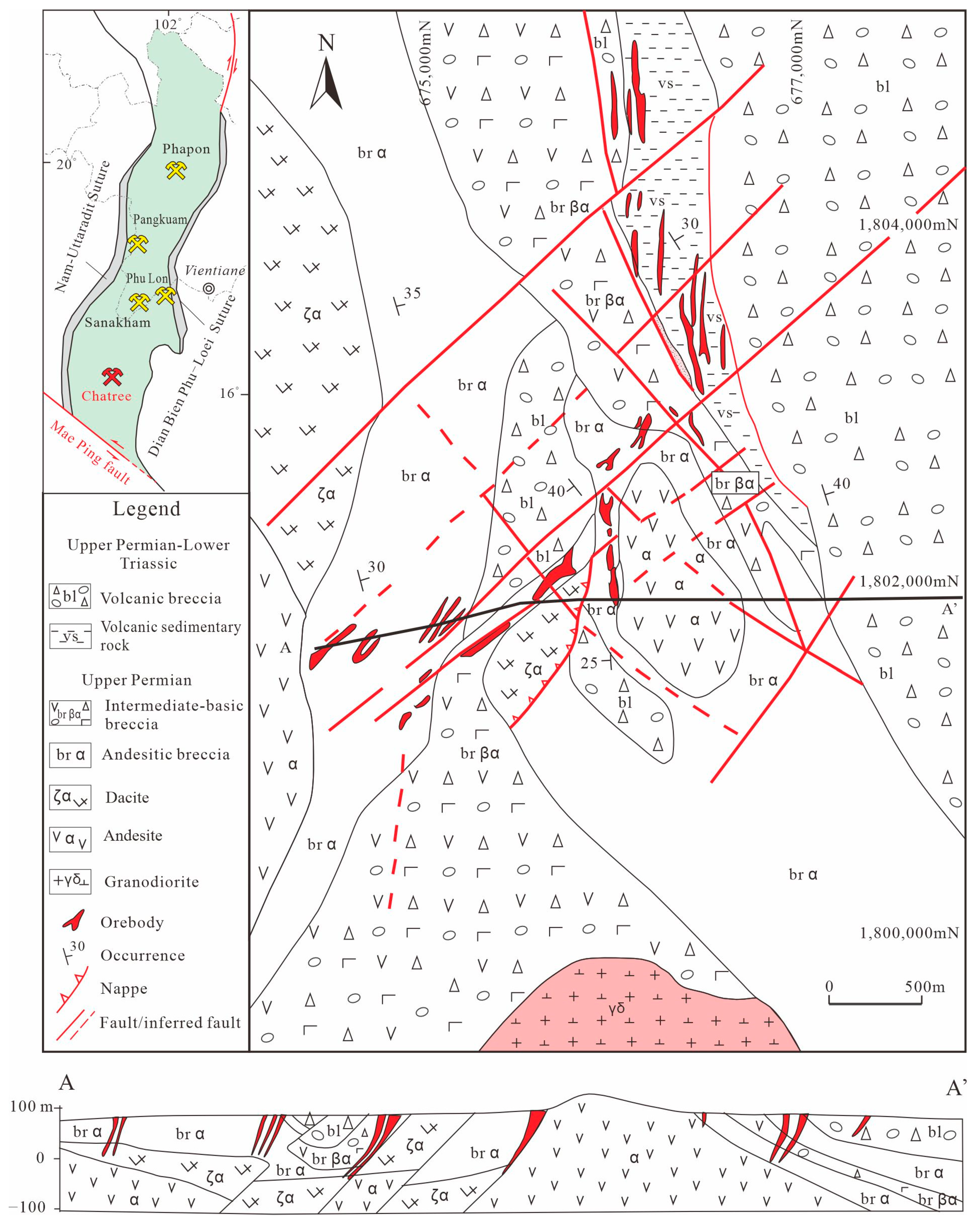
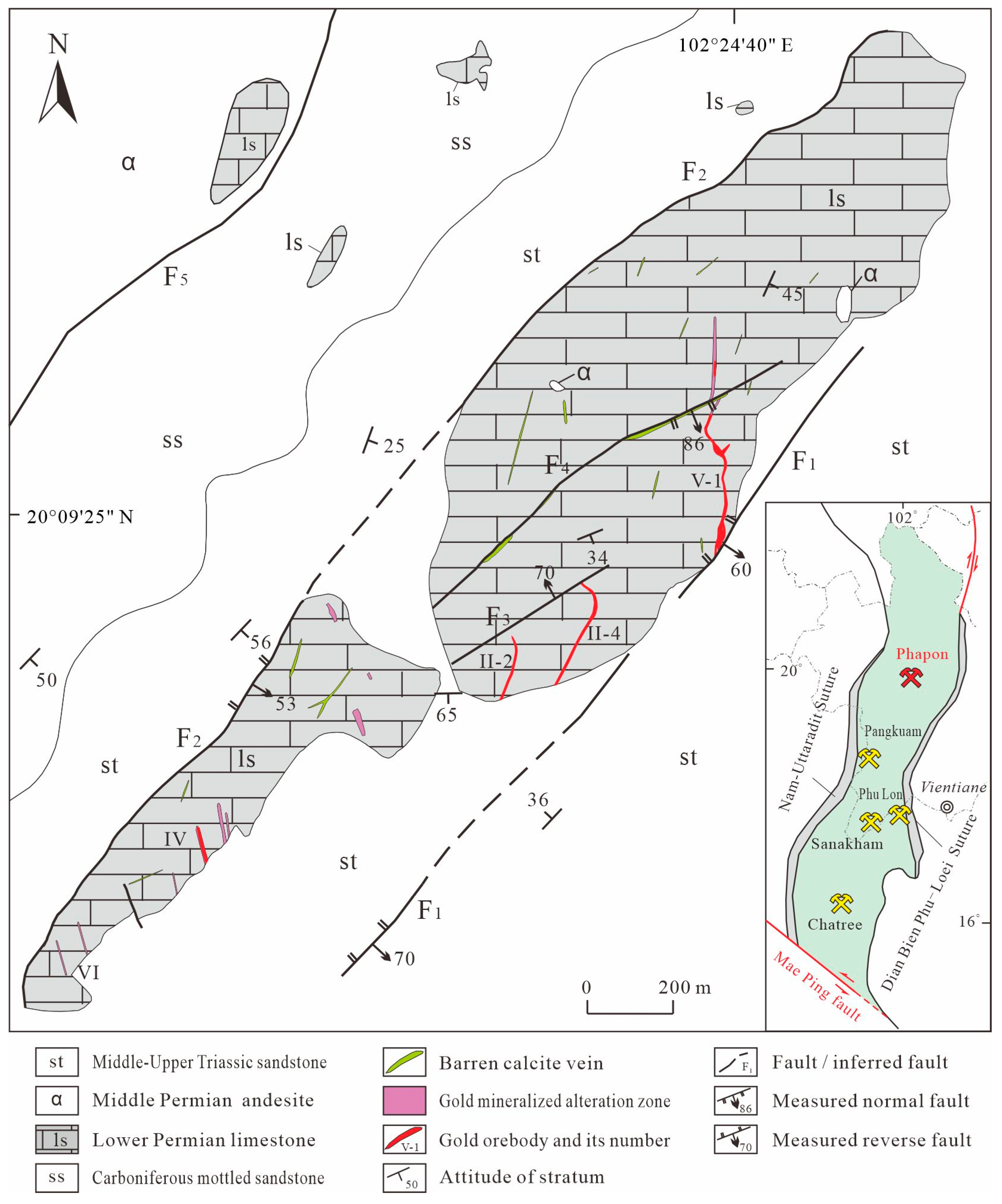
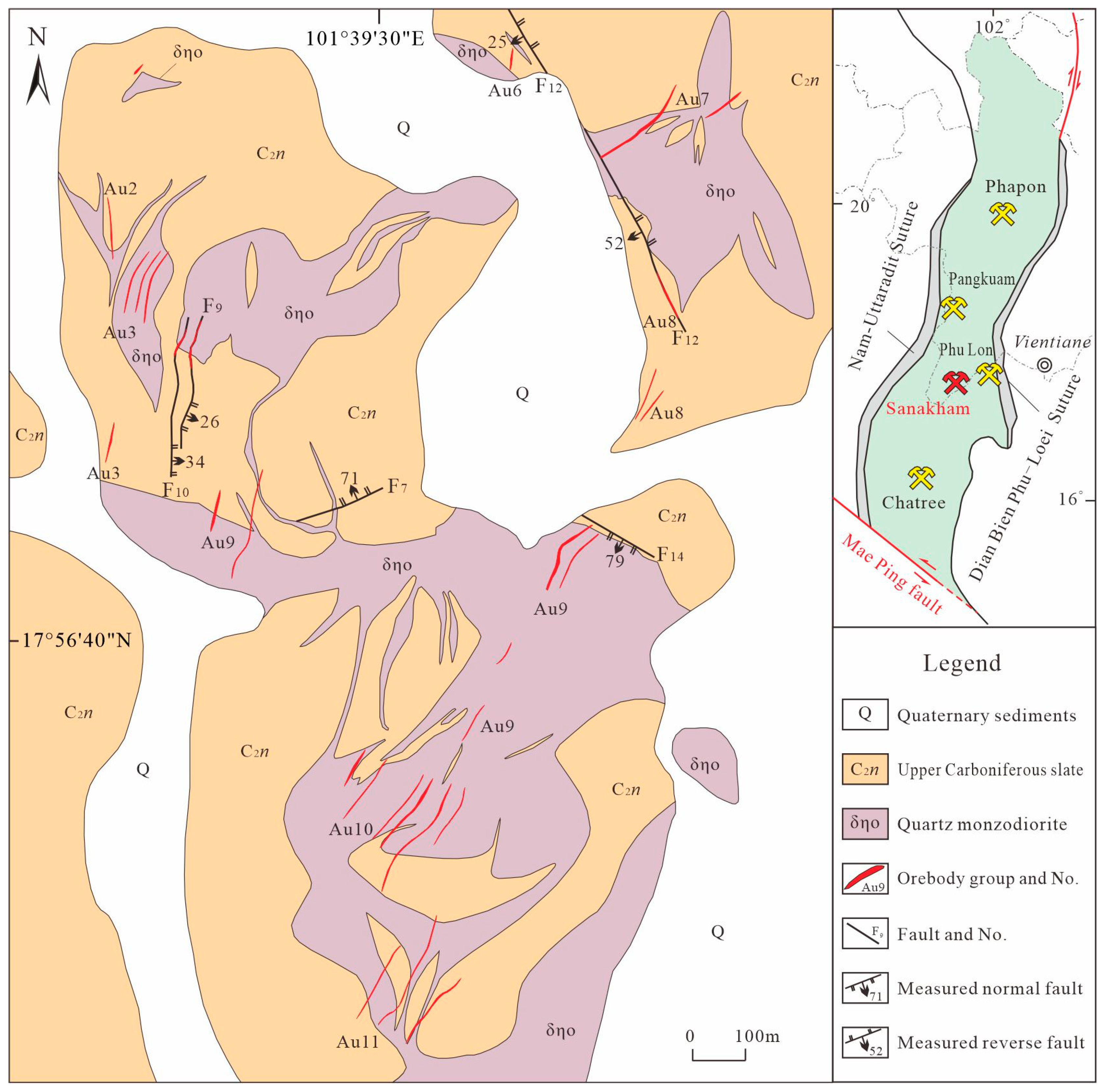
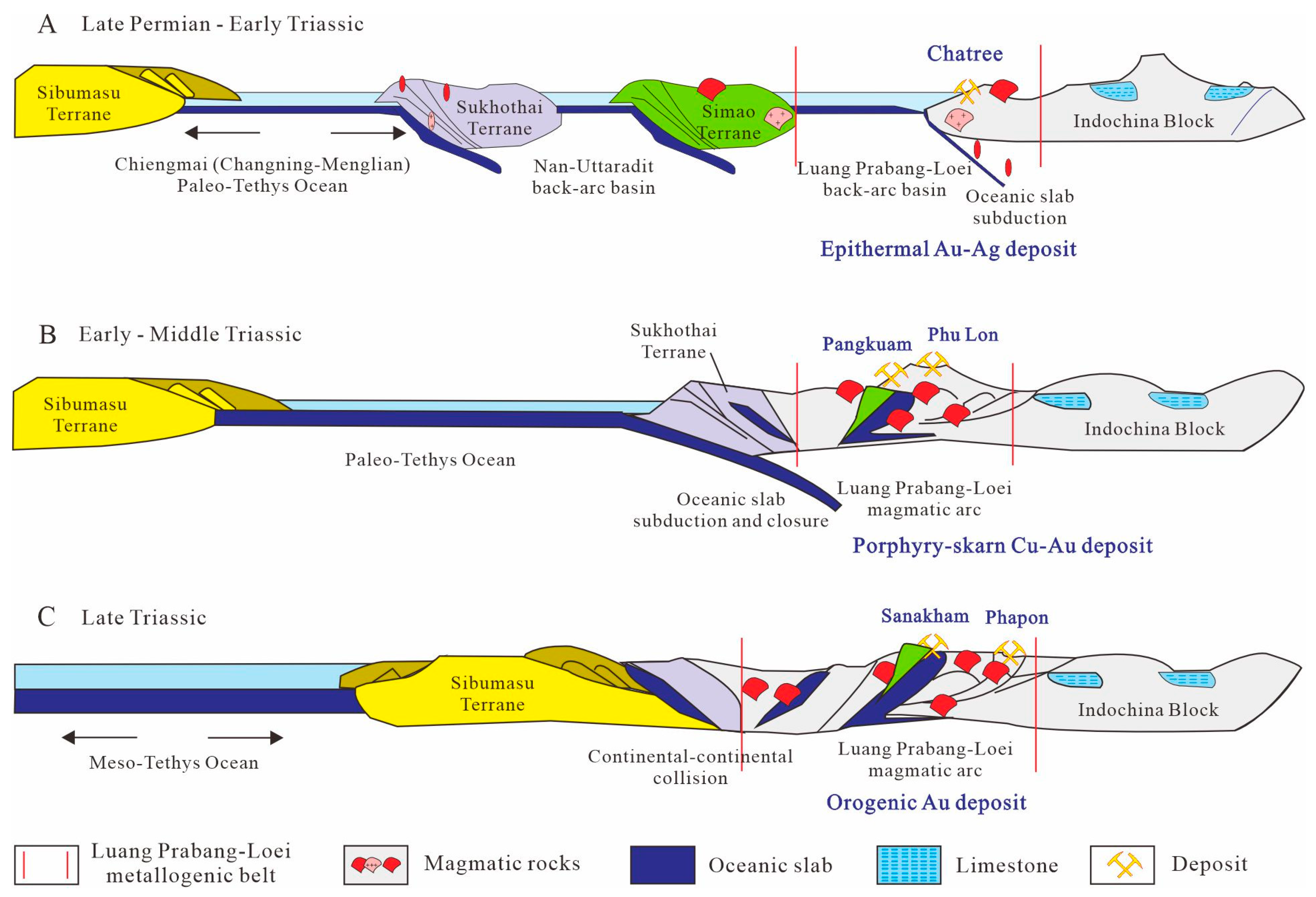
Disclaimer/Publisher’s Note: The statements, opinions and data contained in all publications are solely those of the individual author(s) and contributor(s) and not of MDPI and/or the editor(s). MDPI and/or the editor(s) disclaim responsibility for any injury to people or property resulting from any ideas, methods, instructions or products referred to in the content. |
© 2025 by the authors. Licensee MDPI, Basel, Switzerland. This article is an open access article distributed under the terms and conditions of the Creative Commons Attribution (CC BY) license (https://creativecommons.org/licenses/by/4.0/).
Share and Cite
Guo, L.; Zaw, K.; Liu, S.; Yang, Y.; Nie, F.; Wu, S.; Shi, M.; Huang, C.; Zhang, X.; Liang, H.; et al. A Review of Carboniferous-Triassic Tectonic-Magmatic Evolution of Luang Prabang–Loei Metallogenic Belt in Laos and Thailand and Implications for Gold–Copper Mineralization. Geosciences 2025, 15, 68. https://doi.org/10.3390/geosciences15020068
Guo L, Zaw K, Liu S, Yang Y, Nie F, Wu S, Shi M, Huang C, Zhang X, Liang H, et al. A Review of Carboniferous-Triassic Tectonic-Magmatic Evolution of Luang Prabang–Loei Metallogenic Belt in Laos and Thailand and Implications for Gold–Copper Mineralization. Geosciences. 2025; 15(2):68. https://doi.org/10.3390/geosciences15020068
Chicago/Turabian StyleGuo, Linnan, Khin Zaw, Shusheng Liu, Yongfei Yang, Fei Nie, Songyang Wu, Meifeng Shi, Chunmei Huang, Xiangfei Zhang, Huimin Liang, and et al. 2025. "A Review of Carboniferous-Triassic Tectonic-Magmatic Evolution of Luang Prabang–Loei Metallogenic Belt in Laos and Thailand and Implications for Gold–Copper Mineralization" Geosciences 15, no. 2: 68. https://doi.org/10.3390/geosciences15020068
APA StyleGuo, L., Zaw, K., Liu, S., Yang, Y., Nie, F., Wu, S., Shi, M., Huang, C., Zhang, X., Liang, H., Zeng, X., & Xu, S. (2025). A Review of Carboniferous-Triassic Tectonic-Magmatic Evolution of Luang Prabang–Loei Metallogenic Belt in Laos and Thailand and Implications for Gold–Copper Mineralization. Geosciences, 15(2), 68. https://doi.org/10.3390/geosciences15020068








